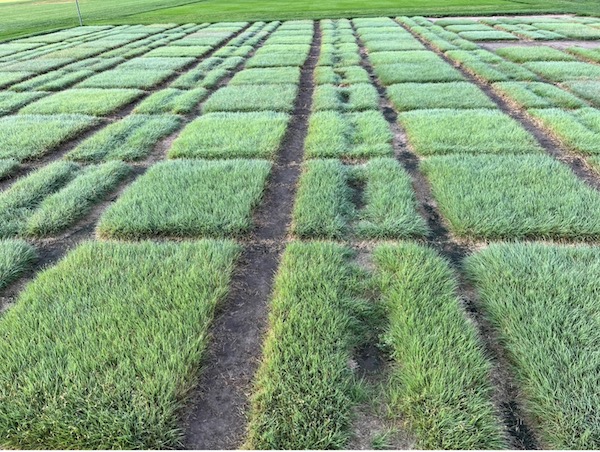Background
Buffalograss is an important warm-season turfgrass species, suited to the hot and dry summer we are experiencing this year. Our turfgrass breeding program is developing turf-type buffalograss with improved visual and functional quality, pest resistance, color retention, establishment rate, sod strength, and traits important for seed and sod production. Sod strength is an important characteristic for sod producers but is also an important attribute of a successful buffalograss turf because it is closely associated with stolon numbers, their density, length, and architecture.
Objective
Identify top performing buffalograss lines to advance as potential seed parents and for sod production.
Methods
Advanced buffalograss breeding lines (n=24) and two industry standard cultivars (‘Prestige’ and ‘Legacy’) were grown in the greenhouse in 72 cell propagation trays. On May 26, 2022, the plugs were transplanted to the East Campus Turf Facility and arranged as a replicated complete block design with three replications. Each plot was 4 ft x 8 ft and planted with 28 plugs at 12 in spacing. All plots were evaluated for establishment rate (6/28/22 – 1 month post planting), visual quality (9/29/22), and spring green-up (5/11/23). On 6/6/23, a 12 in wide strip of sod (approximately 1 in thick) was cut 6 in from the west end of each plot aligned with the shorter side of each plot, producing strips of sod that were 1 ft x 4 ft long. A 2 ft section was removed from the center of each strip and measured for sod strength. The remaining 1 ft ends on either end of the sod were tamped down and allowed to regrow; their regrowth, measured as greenup post sod cutting was measured at 5, 13, and 20 days post cutting. Another strip of sod was cut on 7/10/23 as described except the sod was collected 6 in from the previous cut and the 1 ft ends were transplanted to a new area and managed like a sod grow-in with more frequent irrigation than was used to manage the established plot. The transplanted sod was evaluated for recovery 9 days post cutting.
Results
Variability was observed for all traits among the lines evaluated except for recovery 20 days post the first cutting. Among the 8 ratings with variability (establishment, quality, spring greenup, early and late sod strength, early and late greenup post sod cutting, and recovery), 9 of the experimental entries performed as good or better than the commercial cultivars. Of note, 6 lines outperformed the industry standard for visual quality, 3 for spring greenup, 1 for early sod strength and 1 for greenup post sod cuttings. The commercial entries performed among the best during the second sod cutting and for recovery post sod establishment, along with 11 and 7 experimental lines, respectively.
Conclusions
- Buffalograss cultivars with exceptional sod strength benefit sod producers, but also have exceptional sod characteristics that promote a dense buffalograss stand.
- The industry standards performed among the best for many rating categories, suggesting they remain among the best vegetative buffalograss cultivars on the market.
- Some experimental lines outperformed the industry checks for visual quality and spring greenup while sharing the same functional quality as the industry standards.
